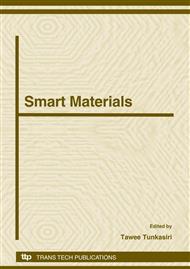p.229
p.233
p.237
p.241
p.245
p.249
p.253
p.257
p.261
Assessment of Mechanical Properties and Transformation Behavior of Locally-Made Ni-Ti Alloys Used in Orthodontics
Abstract:
Ni-Ti alloy wires have been widely used in clinical orthodontics because of their properties of superelasticity (SE) and shape memory effect (SME). The purpose of this study was to assess the mechanical properties and phase transformation of 50.7Ni-49.3 Ti (at%) alloy (NT) and 45.2Ni-49.8Ti-5.0Cu (at%) alloy (NTC), cold-rolled with various percent reductions. To investigate SE and SME, heat-treatment was performed at 400°C and 600°C for 1 h. The specimens were examined using an Energy-Dispersive X-ray Spectroscope (EDS), Differential Scanning Calorimeter (DSC), Universal Testing Machine (Instron), Vickers Hardness Tester and Optical Microscope (OM). On the three-point bending test, the superelastic load-deflection curve was seen in NTC heat-treated at 400°C. Furthermore, NT heat-treated at 400°C with 30% reduction produced a partial superelastic curve. For SME, no conditions revealed superelasticity at the oral temperature. Micro-hardness value increased with greater percentage reduction. The average grain size for all specimens was typically 55-80 µm. The results showed that locally-made Ni-Ti alloys have various transformation behaviors and mechanical properties depending on three principal factors: chemical composition, work-hardening (the percent reduction) and heat-treatment temperature.
Info:
Periodical:
Pages:
245-248
Citation:
Online since:
August 2008
Price:
Сopyright:
© 2008 Trans Tech Publications Ltd. All Rights Reserved
Share:
Citation:


